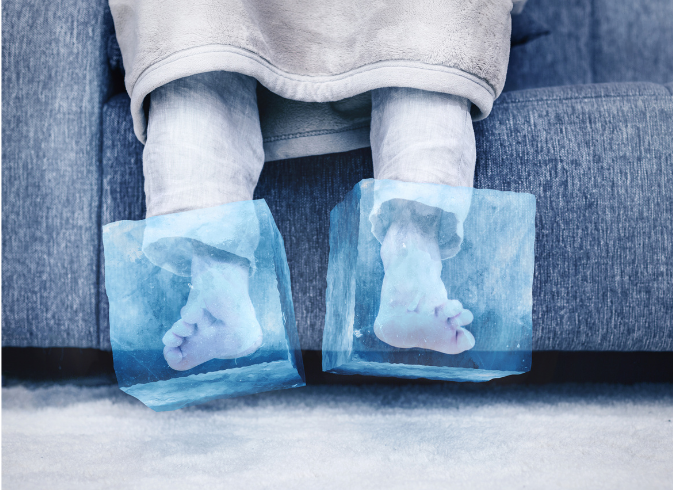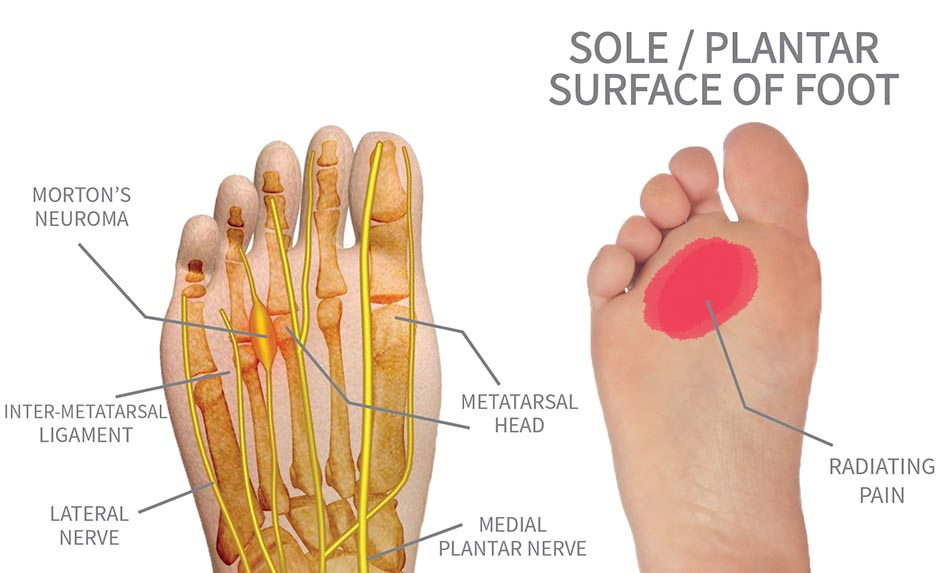Are you experiencing pain in the ball of your foot
 Morton’s Neuroma is a painful condition that is experienced in the ball of the foot and is most commonly affecting the area between your third and fourth toes. People describe the condition as if they are standing on a stone in their shoe, a consistent pain.
Morton’s Neuroma is a painful condition that is experienced in the ball of the foot and is most commonly affecting the area between your third and fourth toes. People describe the condition as if they are standing on a stone in their shoe, a consistent pain.
Physiologically, what is happening is that there is a thickening of the tissue around a nerve leading into the toes. This thickening essentially presses on the nerve and can lead to sharp, burning pains. Other symptoms experienced include stinging, burning, or numbness in the toes (Thomson et al., 2004).
Causes of Morton’s Neuroma
It is not always clear why some people develop this condition and others do not, however it seems to occur when there is irritation, injury, or pressure to one of the nerves that lead to your toes.
Risk Factors affecting the pain in the ball of your foot
High Heels
Frequently wearing high-heeled shoes or tight fit shows can place pressure on the toes or the ball of the foot. Shoes that are tight or ill-fitting can place extra pressure on your toes and cause pain in the ball of your foot.
Hight Impact Sports
Participating in high-impact athletic activities such as running may subject your feet to repetitive pressure and trauma. Also, sports that require tight shoes such as rock climbing, or snow skiing can sometimes lead to excess pressure and irritation on the toes.
Foot Deformities
People who have bunions, hammertoes, high arches, or flatfeet are at higher risk of developing Morton’s neuroma.
Treatment for the pain in the ball of your foot
Treatment may depend on the severity of the condition; however conservative treatment is often recommended. Some of the lifestyle home-based remedies that are often advised include:
- Take anti-inflammatory medications to reduce pain and swelling.
- Changing footwear, opting for shoes with a broad toe box and extra depth. In addition to this reducing the among of times, you are wearing high heels or tightly fitted shoes.
- Resting from activities, which aggravate the condition for a few weeks whilst the pain is present.
- Ice massage may also be useful in helping to reduce the pain and swelling.
When conservative treatment does not seem to improve the condition, doctors may look to opt for surgical procedures with the use of injections, decompression surgery, or surgical removal of the nerve causing the issues. However, there is another treatment that is showing promise, which may help those suffering from this condition to avoid such invasive surgery altogether. This is and cryosurgery and cryotherapy (Jain & Mannan., 2013).
Cryotherapy for Morton’s Neuroma
 Cryotherapy is becoming increasingly accepted as a well-known treatment in the pain management community for a variety of conditions. A recent area that has made significant progress in the treatment of Morton’s neuroma is the use of cryosurgery. This is slightly different from standard cryotherapy, however is a treatment that is a lot less invasive than traditional surgery and showing promise as an effective treatment (Cazzato et al., 2016).
Cryotherapy is becoming increasingly accepted as a well-known treatment in the pain management community for a variety of conditions. A recent area that has made significant progress in the treatment of Morton’s neuroma is the use of cryosurgery. This is slightly different from standard cryotherapy, however is a treatment that is a lot less invasive than traditional surgery and showing promise as an effective treatment (Cazzato et al., 2016).
The procedure involves shrinking and freezing the nerve tissue, which reduces its excitability and eventually destroying the small area of the nerve causing the irritation. This prevents future inflammation of that nerve and stops the pain of Morton’s Neuroma allowing the individual suffering to return to the lifestyle they had before developing the painful condition. During the procedure the area is anesthetized, and a very tiny incision is made over the painful area. Then under ultrasound guidance, a probe is inserted and then the freezing is initiated for a period of 2-3 minutes. This is repeated between 2-4 times depending on the severity of the condition. Patients who undergo cryosurgery have minimal pain in the recovery period and can return to normal daily activities within just a couple of days, however, it can take up to 4 weeks to see the full effect of the treatment. To learn more about the cryosurgery procedure click here.
Is there a role for Localised Cryotherapy?
 Whilst we do not offer cryosurgery here at Cryojuvenate, the use of localised cryotherapy may also be a promising adjunct treatment to help with this condition. Any sort of cold pain relief (gels, ice packs, etc.) are considered a form of cryotherapy, but the localised treatment we offer as a medical-grade cryotherapy treatment is significantly stronger and likely to have a much greater effect at reducing pain around the affected area. Whilst this area is in the early stages of research, the localised freezing around Morton’s Neuroma can help with the reductions in nerve excitability and a disruption to the pain cycle the patient is experiencing. We, therefore, see this as a promising treatment that may be worth exploring if you are suffering from this condition.
Whilst we do not offer cryosurgery here at Cryojuvenate, the use of localised cryotherapy may also be a promising adjunct treatment to help with this condition. Any sort of cold pain relief (gels, ice packs, etc.) are considered a form of cryotherapy, but the localised treatment we offer as a medical-grade cryotherapy treatment is significantly stronger and likely to have a much greater effect at reducing pain around the affected area. Whilst this area is in the early stages of research, the localised freezing around Morton’s Neuroma can help with the reductions in nerve excitability and a disruption to the pain cycle the patient is experiencing. We, therefore, see this as a promising treatment that may be worth exploring if you are suffering from this condition.
If you are experiencing pain in the ball of your foot and would like to try Localised Cryotherapy please get in touch: Click here





